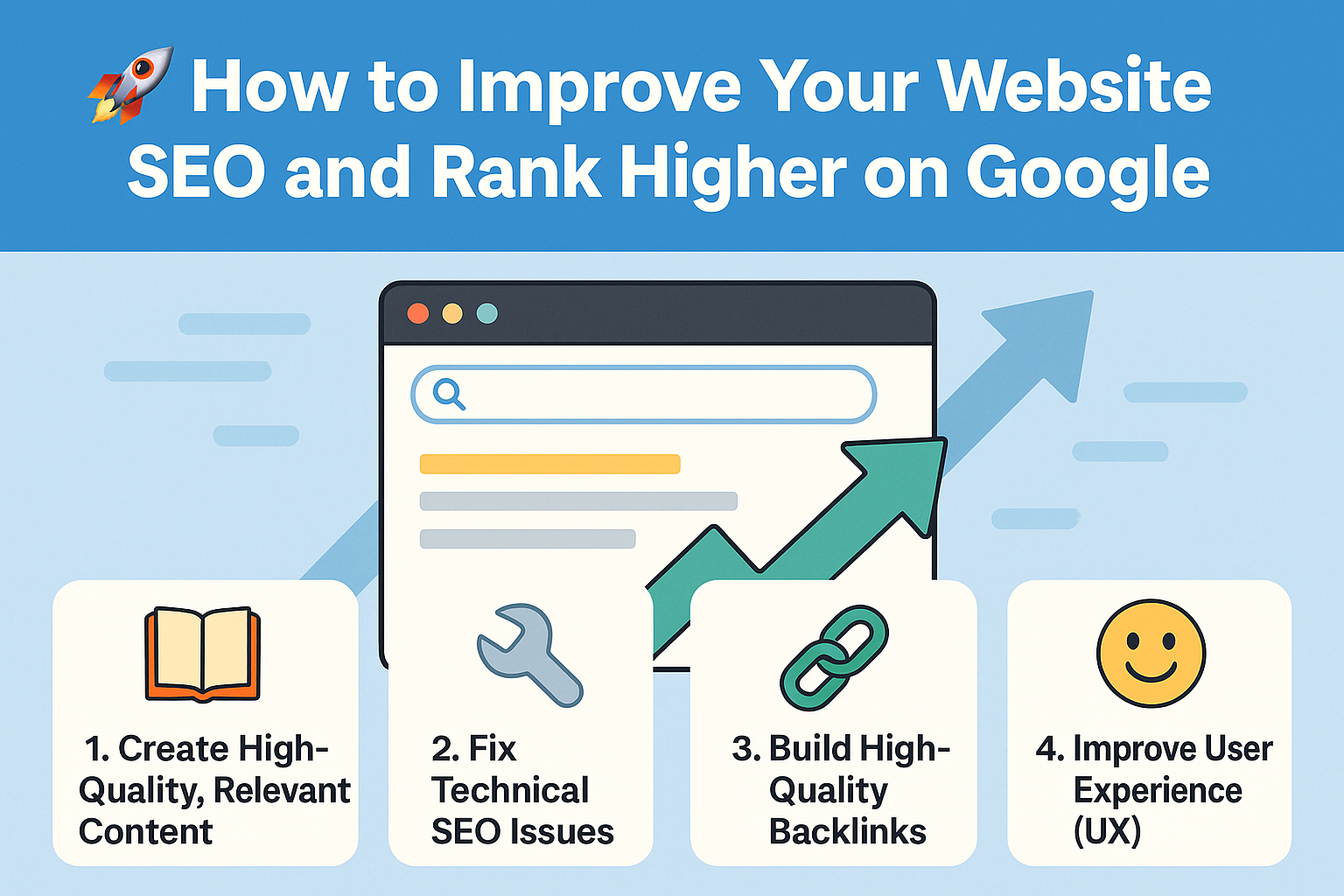🚀 How to Improve Your Website SEO and Rank Higher on Google

Want to rank higher on Google? It's not about tricks or shortcuts—it's about creating value and following a strategy rooted in Google’s actual guidelines. In this comprehensive guide, you’ll learn how to build a future-proof SEO strategy that drives organic traffic and positions your website as a trusted authority.
📌 What Does Google Actually Want?
According to Google’s own documentation, websites should focus on content that is:
- Helpful and original
- Written for people, not search engines
- Authoritative and well-sourced
- Well-structured, mobile-friendly, and fast
Let’s break down the 5 pillars of a high-ranking SEO strategy.
1. 📚 Create In-Depth, Relevant Content
Content is still king—but only if it’s useful. Here's how to make your content Google-friendly:
- Map User Intent: Identify whether the searcher is looking to buy, learn, compare, or solve a problem.
- Use Long-Tail Keywords: Focus on specific queries like “best eco-friendly running shoes under $100.”
- Write Rich, Skimmable Content: Use headings (H2/H3), bullet points, and visual elements to make it easier to digest.
- Link Internally: Help search engines crawl your site by linking to related posts and landing pages.
- Answer Related Questions: Add FAQs or use People Also Ask (PAA) questions from Google for bonus reach.
🛠 Tools: AnswerThePublic, Ubersuggest, CopyRanker
2. 🛠️ Fix Technical SEO Problems
Technical SEO ensures that Google can discover, crawl, and index your website properly.
- Optimize Load Speed: Compress images, use caching, and reduce unused JavaScript. Aim for < 2 seconds.
- Use Mobile-Responsive Design: Over 60% of users are on mobile. Use flexible layouts and readable text sizes.
- Fix Broken Links and Crawl Errors: Check Google Search Console regularly for issues.
- Implement Schema Markup: Help Google understand your content with structured data.
- Create XML Sitemaps and Robots.txt: These help search engines navigate your site.
🛠 Tools: PageSpeed Insights, GTmetrix, TechnicalSEO.com Tools
3. 🔗 Earn High-Quality Backlinks
Backlinks from reputable sites signal trust to Google. Here's how to build them:
- Publish Link-Worthy Assets: Create original research, free tools, or comprehensive guides that people want to cite.
- Write Guest Posts: Reach out to niche blogs or publishers with your expertise and include backlinks.
- Use HARO: Sign up for Help a Reporter Out and contribute quotes to journalists.
- Reclaim Unlinked Mentions: Use Ahrefs or SEMrush to find sites mentioning your brand without linking.
4. 😀 Optimize for User Experience (UX)
Good UX = lower bounce rates and more time on site, both of which are positive SEO signals.
- Simple Navigation: Keep your main menu focused. Use breadcrumbs and internal links.
- Readable Layout: Use large fonts, whitespace, and clean formatting.
- Interactive Elements: Use accordions, quizzes, or image sliders to engage users.
- Clear CTAs: Guide users toward subscribing, buying, or contacting you.
💡 Pro Tip: Use session recording tools like Hotjar or Microsoft Clarity to watch how users interact with your pages.
5. 📈 Monitor Results and Iterate
SEO isn’t set-it-and-forget-it. It’s a living strategy. Use data to refine your efforts:
- Track Keyword Rankings: Are you climbing? Tools like SE Ranking or Ahrefs show movements.
- Review Analytics: Bounce rate, pages per session, and average time on site indicate content quality.
- Refresh Old Posts: Add new stats, update links, and expand with fresh insights.
- Split-Test Titles and CTAs: Test which headlines or call-to-actions increase clicks.
🛠 Tools: Google Analytics, GSC, SEMrush
✅ Bonus: Submit Your Sitemap
Make sure your sitemap is up to date and submitted in Search Console. It tells Google what to index and when.
🎯 Final Thoughts
Improving SEO isn’t about beating an algorithm—it’s about being the best answer to a user’s question.
Focus on:
- Delivering clear, actionable content
- Fixing technical weaknesses
- Building real authority through content and backlinks
- Making your site delightful to use
- Reviewing performance and adjusting constantly
Ready to boost your search rankings? Use CopyRanker to generate optimized articles, titles, and meta tags in seconds—backed by actual Page 1 data.
